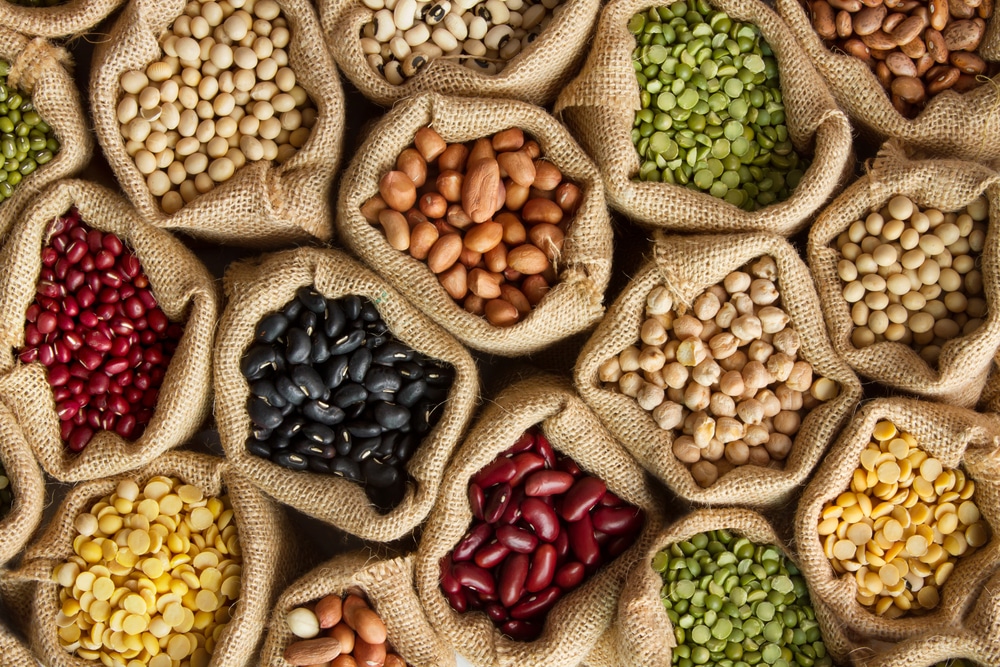
Legumes are a nutritional powerhouse, especially for vegetarians! They’re packed with protein, full of fiber, and contain a host of vitamins, minerals, complex carbohydrates, and antioxidants.
Is it a legume or a pulse? What’s the deal?
If you’ve heard the terms legumes and pulses used interchangeably and are a bit confused, you’re not alone. Legumes are plants in the Fabacae family, and pulses are their edible seeds. The Food and Agriculture Organization (FAO) recognizes 11 different kinds of pulses including dry beans, dry broad beans, dry peas, chickpeas, cow peas, pigeon peas, and lentils. The term pulses is limited to crops that are harvested as dry grains. So for example edamame, which is harvested while still green and eaten fresh (as opposed to dried) is a legume, but not a pulse. Dried soy beans, on the other hand, are pulses… which come from legumes.
Are you with me? Let’s get into some legumes!
Beans
The nutrition profile varies from bean to bean, but we can say in general terms that beans are a good source of dietary fiber, protein, folate, manganese, iron, potassium, magnesium, vitamin B1, and vitamin K. Beans, beans, they’re good for your heart…. but if the second part of that rhyme concerns you, try tossing the soaking water next time you cook dried beans. You'll be tossing out a good amount of flatulence causing compounds (but also great flavor, so pick your battles).
Studies have shown that eating foods rich in fiber, such as beans, help prevent heart disease. The fiber also helps lower cholesterol and stabilizes blood sugar. Beans are a great source of plant-based protein, with one cup providing up to 15 grams of protein, depending on the bean.
Try mixing up your beans! Maybe you’re familiar with black beans and kidney beans, but have you given mung beans or adzuki beans a try? These smaller beans don’t require pre-soaking before cooking, so are great for quick and easy meals.
Peas
Give peas a chance! This includes yellow peas, green peas, and chickpeas. Peas are totally superfoods! They contain about 12.5 grams of fiber per cup, which is 50% of the recommended daily intake of dietary fiber. About two-thirds of the fiber in peas is insoluble, which is great for digestive health, particularly in the colon. The remaining third is soluble fiber, which can help lower our LDL-cholesterol, total cholesterol, and triglycerides à mega important for a healthy heart.
The combination of protein and dietary fiber in peas is key for stabilizing blood sugar levels, as both protein and fiber move through our digestive systems at a moderate pace. This also helps us feel satisfied for longer after eating peas, which can help prevent over eating. Peas are packed with antioxidant nutrients like vitamin C, vitamin E, and beta-carotene, but also contain concentrated supplies of antioxidant phytonutrients such as flavonoids and polyphenols.
Lentils
How do we love lentils? Let me count the ways. These lovely little legumes are a very good source of cholesterol-lowering dietary fiber. The soluble fiber in lentils helps to keep blood sugar stable, while providing a steady source of energy. But the benefits don’t stop there! Lentils are a great source of non-heme (plant-based) iron, in addition to being a good source of plant-based protein, which is good news for us veg heads. They’re also a great source of heart-healthy folate and magnesium, phosphorous, manganese, zinc, potassium, and B6.
Peanuts
The name is misleading, because peanuts aren’t actually nuts — they’re legumes! Peanuts are packed with protein and are a dense source of energy; a little goes a long way. They’re a good source of antioxidant vitamin E, niacin, and folate. Peanuts also contain resveratrol, which is the phenolic compound found in red wine that has been attributed with cardiovascular benefits, and oleic acid, the healthy fat found in olive oil.
Legumes photo via Shutterstock.


Sam says
Great detail Katie ?